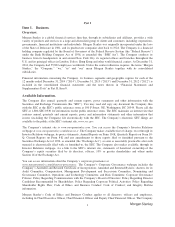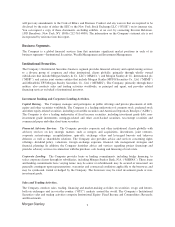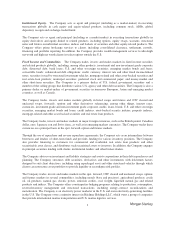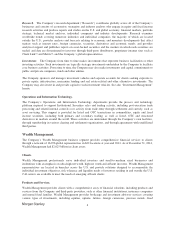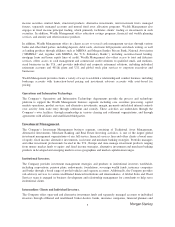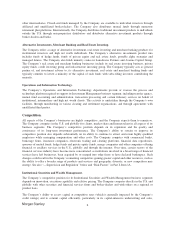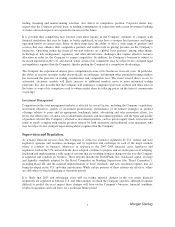Morgan Stanley 2014 Annual Report Download - page 15
Download and view the complete annual report
Please find page 15 of the 2014 Morgan Stanley annual report below. You can navigate through the pages in the report by either clicking on the pages listed below, or by using the keyword search tool below to find specific information within the annual report.
jurisdictional activity, substitutability, and complexity, which is generally consistent with the methodology
developed by the Basel Committee. The second method would use similar inputs, but would replace
substitutability with use of short-term wholesale funding and generally would result in higher surcharges than the
Basel Committee framework. A G-SIB’s surcharge would be the higher of the surcharges determined under the
two methods. Under the proposal, the G-SIB surcharge must be satisfied using Common Equity Tier 1 capital
and would function as an extension of the capital conservation buffer. The Federal Reserve estimates that its
proposal could result in G-SIB surcharges ranging from 1.0% to 4.5% of a G-SIB’s RWAs. The proposal would
be phased in between January 1, 2016 and January 1, 2019.
The Basel Committee is in the process of considering revisions to various provisions of the Basel III framework
that, if adopted by the U.S. banking agencies, could result in substantial changes to U.S. Basel III. In particular,
the Basel Committee has finalized a new methodology for calculating counterparty credit risk exposures, the
standardized approach for measuring counterparty credit risk exposures (“SA-CCR”); has finalized a revised
framework establishing capital requirements for securitizations; and has proposed revisions to various regulatory
capital standards. In each case, the impact of these revised standards on the Company and its U.S. Subsidiary
Banks is uncertain and depends on future rulemakings by the U.S. banking agencies.
In addition to capital regulations, the U.S. banking agencies and the Basel Committee have adopted, or are in the
process of considering, liquidity standards. The Basel Committee has developed two standards intended for use in
liquidity risk supervision, the Liquidity Coverage Ratio (“LCR”) and the Net Stable Funding Ratio (“NSFR”). The
LCR generally requires banking organizations to maintain an amount of high-quality liquid assets that is no less
than 100% of their total net cash outflows arising from significant stress over a prospective 30 calendar-day period.
In September 2014, U.S. banking regulators issued a final rule to implement the LCR in the U.S. (“U.S. LCR”).
The U.S. LCR applies to the Company and its U.S. Subsidiary Banks. The U.S. LCR is more stringent in certain
respects than the Basel Committee’s version of the LCR as it includes a generally narrower definition of debt and
equity securities that qualify as high-quality liquid assets, different methodologies and assumptions for
calculating net cash outflows during the 30-day stress period, a maturity mismatch add-on, and a shorter, two-
year phase-in period that ends on December 31, 2016. Additionally, under the U.S. LCR, a banking organization
must submit a liquidity compliance plan to its primary federal banking agency if it fails to maintain the minimum
U.S. LCR requirement for three consecutive business days. Beginning on January 1, 2015, the Company and its
U.S. Subsidiary Banks are required to maintain a minimum U.S. LCR of 80%. This minimum requirement will
increase to 90% beginning on January 1, 2016, and will be fully phased in at 100% beginning on January 1,
2017. The Company and its U.S. Subsidiary Banks must calculate their respective LCR on a monthly basis
during the period between January 1, 2015 and June 30, 2015, and on each business day starting on July 1, 2015.
The NSFR is defined as the ratio of the amount of available stable funding to the amount of required stable
funding. The standard’s objective is to reduce funding risk over a one-year horizon by requiring banking
organizations to fund their activities with sufficiently stable sources of funding in order to mitigate the risk of
future funding stress. In October 2014, the Basel Committee finalized revisions to the original December 2010
version of the NSFR. The U.S. banking agencies are expected to issue a proposal to implement the NSFR in the
U.S. The Company continues to evaluate the NSFR and its potential impact on the Company’s current liquidity
and funding requirements.
See also “Management’s Discussion and Analysis of Financial Condition and Results of Operation—Liquidity
and Capital Resources—Basel Liquidity Framework and Regulatory Requirements” in Part II, Item 7.
Capital Planning, Stress Tests and Dividends. Pursuant to the Dodd-Frank Act, the Federal Reserve has adopted
capital planning and stress test requirements for large bank holding companies, including the Company, which form
part of the Federal Reserve’s annual Comprehensive Capital Analysis and Review (“CCAR”) framework. Under the
Federal Reserve’s capital plan rule, the Company must submit an annual capital plan to the Federal Reserve, taking
into account the results of separate stress tests designed by the Company and the Federal Reserve.
11


